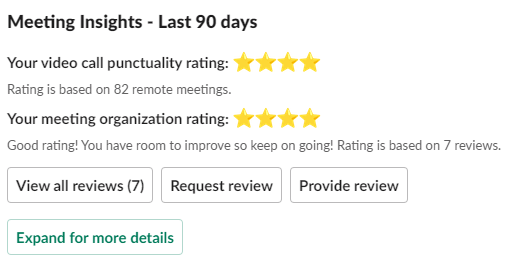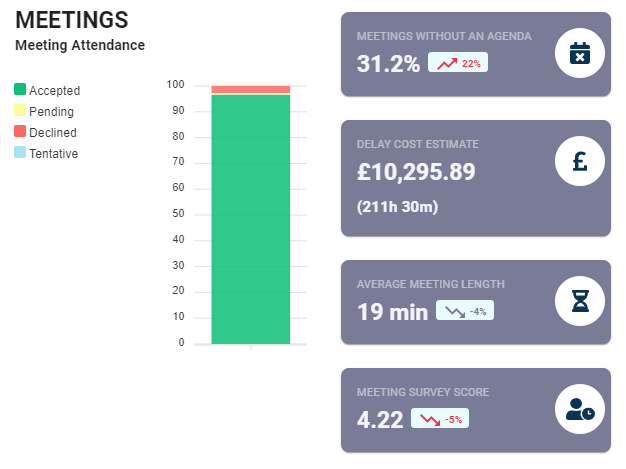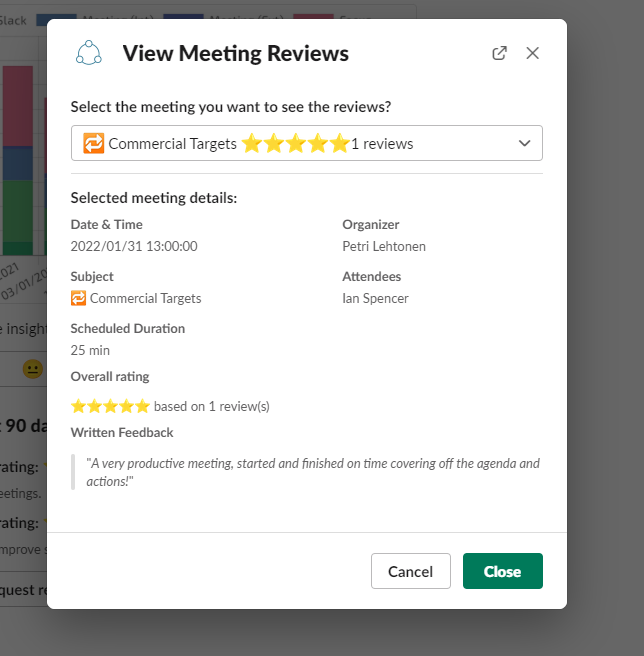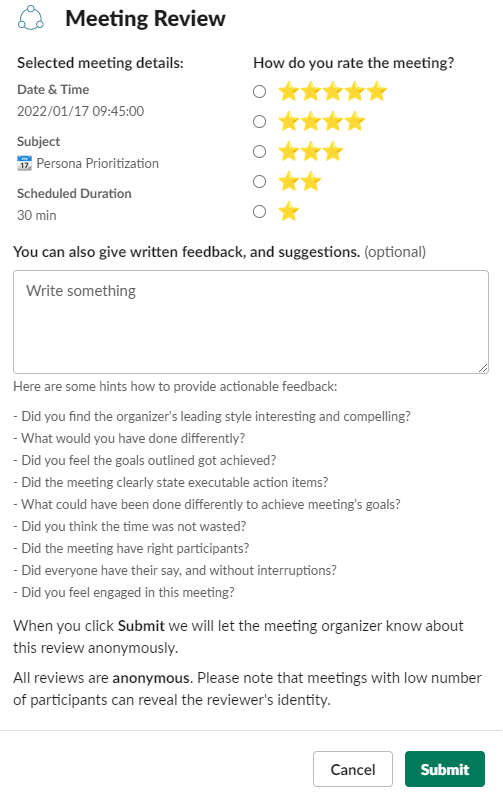Meeting OKRs: 10 Examples to Improve Meeting Culture
Improve meeting culture with meeting OKRs and Flowtrace analytics. Learn 10 examples to enhance productivity, engagement, and collaboration in...
Learn how Flowtrace's meeting metrics can optimize schedules, track progress, and improve meeting culture to drive better business outcomes and boost productivity.
Meetings are a ubiquitous part of modern work culture. While they can be an important tool for collaboration and decision-making, they can also be a major source of frustration for employees and a drain on productivity. In fact, studies show that the average employee spends nearly 30 hours per month in meetings (23 hours per week for executives), and nearly 50% of employees feel that they attend too many meetings.
One of the biggest challenges with meetings is that they can be difficult to track and measure. Companies often struggle to understand how much time is being spent in meetings, which meetings are the most important, and how to make meetings more productive and engaging for attendees. This can result to poor meeting culture.
This is where Flowtrace comes in. Flowtrace is a company analytics platform that provides valuable insights into workplace apps and tools, including meetings. With Flowtrace, companies can gain a 360-degree view into their business, covering productivity, meeting culture, communication, collaboration, and engagement metrics. This allows them to identify areas of improvement and make data-driven decisions to optimize their business.
One of the key areas of focus for Flowtrace is meeting culture. By tracking key meeting metrics, companies can gain valuable insights into their meeting patterns and identify areas for improvement. Let's take a look at some of the example meeting metrics that Flowtrace provides:

Establishing a positive meeting culture offers numerous advantages that extend beyond individual meetings to enhance overall organizational performance. Here are the key benefits:
Increased Productivity: Well-structured meetings with clear objectives and agendas help ensure that discussions are focused and productive, reducing time wastage and allowing employees to dedicate more time to their core tasks.
Enhanced Employee Engagement: Encouraging active participation and using interactive elements like polls or Q&A sessions foster a sense of involvement and ownership among team members. Engaged employees are more likely to contribute valuable insights and feel more satisfied with their work.
Better Decision-Making: Clear objectives and well-prepared participants lead to more effective and timely decision-making. This ensures that meetings are not just discussions but are instrumental in driving the organization forward.
Reduced Costs: By eliminating unnecessary meetings, adhering to agendas, and preventing meetings from overrunning, organizations can significantly cut down on the financial costs associated with unproductive meeting time. Efficient meetings free up resources and reduce the overall operational costs.
Improved Collaboration: Good meeting culture promotes open communication and collaboration. With well-defined roles and clear follow-up actions, team members are better aligned and can work together more effectively.
Higher Morale and Job Satisfaction: When employees feel that their time is respected and that meetings are productive and meaningful, their job satisfaction and morale improve. This leads to a more positive work environment and lower turnover rates.
Implementing these strategies helps organizations optimize their meeting culture, leading to sustained productivity and a more positive workplace environment.
Flowtrace provides several key meeting metrics that companies can use to gain insights into their meeting patterns and improve their meeting culture. Here are some of the most important meeting metrics to track:
Meeting frequency refers to how often meetings are scheduled in your company. By tracking meeting frequency, you can gain insights into which teams are having too many meetings and which teams don't have enough. This can help you optimize your meeting schedules and reduce the number of unnecessary meetings. Poorly consolidated meetings eat up the deep-work time from your teams.
Agendaless meetings can be an effective way to encourage creativity and innovation, but they can also be challenging to manage. By tracking agendaless meetings, you can identify which meetings are the most productive and engaging, and which ones may need improvement. For example, you may find that some agendaless meetings are running too long or are not focused enough. They might also result in poor decisions.
One-to-one meetings are an important tool for managers to stay connected with their team members, but they can also be time-consuming and unproductive. By tracking meeting duration and frequency for one-to-one meetings, you can identify which managers are doing their job and who needs improvement.
Meeting punctuality refers to how often meetings start and end on time in your company. By tracking meeting punctuality, you can identify teams or individuals who consistently run late to meetings and address the issue. Late arrivals can disrupt the flow of the meeting and reduce productivity. By encouraging employees to be on time and holding them accountable for their punctuality, you can improve the overall meeting culture in your company.

Meeting engagement (vs. meeting multi-tasking) refers to how engaged attendees are during meetings. By tracking meeting engagement, you can identify which meetings are the most productive and engaging, and which meetings may need improvements. You can use this data to identify best practices and share them with other teams, or provide feedback to meeting organizers to help them improve the quality of their meetings.
Once you've tracked your key meeting metrics, the next step is to use that data to optimize your meeting schedules and increase productivity. Here are some tips on how to do this:
By tracking meeting frequency and duration, you can identify which days and times are the busiest for meetings in your company. This information can be used to schedule meetings more strategically, avoiding scheduling too many meetings on the same day, or at the same time. For example, you may find that most meetings are scheduled on Mondays and Fridays, which could be impacting productivity. By spreading out meetings throughout the week, you can create a more balanced schedule and give employees more time to focus on their work.

By tracking meeting frequency, you can identify which meetings may not be necessary or could be consolidated. For example, you may find that some teams are having daily check-ins that could be consolidated into a weekly meeting. By reducing meeting frequency, you can free up more time for employees to focus on their work and be more productive.
By tracking meeting duration, you can identify trends in meeting length and make adjustments to optimize your meeting schedules. For example, you may find that some meetings regularly run over their scheduled time, which can be a major source of frustration for employees. By setting limits on meeting duration, you can encourage meeting organizers to keep the agenda focused and ensure that the meeting stays within its allotted time.

By tracking meeting punctuality, you can identify teams or individuals who consistently run late to meetings and address the issue. Late arrivals can disrupt the flow of the meeting and reduce productivity. By encouraging employees to be on time and holding them accountable for their punctuality, you can improve the meeting culture in your company.

By using meeting metrics to optimize your meeting schedules, you can increase productivity and create a more engaged and focused workplace. In the next section, we'll explore how meeting metrics can be used to set goals and track progress.
Meeting metrics can also be used to provide feedback to meeting organizers and improve the quality of your meetings. Here are some tips on how to do this:
By tracking meeting engagement metrics, you can identify which meetings are the most productive and engaging. You can use this data to identify best practices and share them with other teams, or recognize effective meeting organizers. By doing this, you can encourage other meeting organizers to adopt best practices and improve the quality of their meetings.

By tracking meeting metrics, you can also provide feedback to meeting organizers on areas for improvement. For example, you may find that a particular meeting is consistently running over its scheduled time, or that attendees are not engaged. By providing this feedback to meeting organizers, you can help them make adjustments and improve the quality of their meetings.

When providing feedback to meeting organizers, it's important to use data to support your feedback. By using meeting metrics, you can provide specific examples of areas where the meeting could be improved, such as reducing meeting frequency or improving punctuality. By using data to inform your feedback, you can make it more objective and actionable.
By providing feedback to meeting organizers and using data to drive improvements, you can create a culture of continuous improvement in your company. Encourage meeting organizers to try new formats, provide opportunities for feedback from attendees, and regularly review meeting metrics to make adjustments.
By tracking meeting metrics, companies can identify best practices and drive better business outcomes. Here are some tips on how to do this:
By using meeting metrics to benchmark your meetings against industry best practices, you can identify areas where you're excelling and areas where you may need improvement. For example, you may find that your meeting frequency is higher than industry benchmarks, which could be impacting productivity. By identifying these gaps, you can make adjustments and improve your meeting culture.
Flowtrace's AI recommendations can help identify best practices and drive improvements. For example, the platform may recommend changes to your meeting agenda to increase engagement, or suggest ways to reduce meeting frequency. By using these recommendations, you can make data-driven decisions and improve the quality of your meetings.

By using meeting metrics to identify best practices, you can share these with other teams and encourage them to adopt these practices. For example, you may find that a particular team is having particularly effective meetings. By sharing their best practices with other teams, you can encourage them to adopt these practices and improve their meeting culture.
By tracking meeting metrics over time, you can measure the impact of meeting improvements on business outcomes. For example, you may find that reducing meeting frequency has led to an increase in employee productivity. By measuring the impact of meeting improvements on business outcomes, you can demonstrate the value of these improvements to the business.
Are you ready to try our Flowtrace meeting analytics to improve your meeting culture?
Improve meeting culture with meeting OKRs and Flowtrace analytics. Learn 10 examples to enhance productivity, engagement, and collaboration in...
Expert Meeting Preparation Tips and Tricks from Flowtrace's meeting analytics team on how to prepare for a meeting like a pro.
Flowtrace's meeting analytics platform optimizes time management and productivity by providing insights into workplace calendars, and meetings.